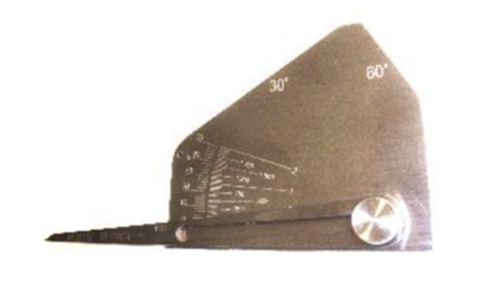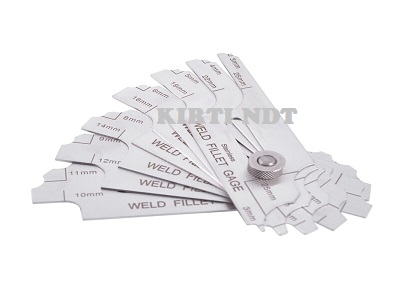Innovative Strategies to Fillet Weld Examination and Testing: Enhancing Weld High Quality and Compliance Requirements
In the world of welding, the high quality and integrity of fillet welds play an important function in making sure the structural soundness and reliability of various commercial parts. With the consistent drive for boosted performance and conformity with strict requirements, the exploration of cutting-edge techniques to fillet weld evaluation and screening has become essential. As sectors progress, the traditional approaches might no much longer be enough in meeting the needs of modern welding applications (Gauge Fillet Weld). By welcoming innovative technologies and techniques, a new perspective of possibilities arises in the world of weld high quality analysis and adherence to compliance criteria.
Advanced Non-Destructive Screening Methods
Making use of modern innovations, progressed non-destructive testing approaches play a vital duty in making certain the honesty and high quality of fillet welds. These techniques, such as phased selection ultrasonic testing (PAUT) and magnetic fragment testing (MPT), deal detailed understandings into the weld's interior structure without creating any kind of damage to the material. PAUT, as an example, makes use of numerous ultrasonic elements to evaluate the weld from various angles, supplying a comprehensive visualization of possible defects like absence of blend or fractures.
By employing these sophisticated non-destructive screening techniques, weld assessors can properly examine the quality of fillet welds, making sure compliance with industry criteria and guidelines. The capacity to spot imperfections early on not only boosts weld quality however additionally avoids pricey rework or failures in structural honesty, underlining the importance of these ingenious screening methods in welding assessments.
Robotics and Automation in Evaluation

The integration of robotics and automation has changed the examination procedure for fillet welds, enhancing efficiency and accuracy in quality analysis. Robotics offer accurate control and repeatability in checking welds, making certain dependable and constant outcomes. Automated systems can be configured to adhere to details inspection paths, guaranteeing extensive insurance coverage of welds and lowering the threat of human mistake.
Robot evaluation systems equipped with innovative sensors can find and determine weld attributes with high accuracy, providing in-depth information for evaluation. These systems can recognize issues such as fractures, lack of blend, and porosity, allowing prompt rehabilitative actions to be taken. In addition, robotics and automation enable real-time information collection and evaluation, providing prompt feedback to operators and facilitating quick decision-making procedures.
Additionally, making use of robotics and automation in fillet weld evaluation boosts overall performance by reducing assessment times and increasing assessment throughput. By enhancing the inspection process, makers can ensure weld quality and compliance criteria are met effectively, inevitably leading to set you back financial savings and enhanced product high quality.
Using Expert System for Evaluation
Artificial knowledge plays a pivotal duty in enhancing the performance and precision of analysis in fillet weld assessment processes. AI algorithms can rapidly process huge quantities of information from weld examinations, detecting issues or inconsistencies that may be testing to recognize with the naked eye.
Additionally, AI systems can gain from past examination data, constantly enhancing their ability to determine possible problems and inconsistencies in fillet welds. This adaptive understanding capability improves the total quality assurance procedure, decreasing the chance of human mistake and making certain that welds meet the required requirements. By incorporating expert system right into fillet weld evaluation, industries can achieve higher levels of efficiency, uniformity, and compliance in their inspection methods.
Portable Devices for On-Site Inspection
Enhancing field evaluation performance, the fostering of portable tools transforms on-site evaluation processes for fillet welds. These tools use adaptability and convenience, allowing inspectors to conduct extensive examinations in different places, consisting of remote or challenging settings. Portable devices such as ultrasonic testing devices, magnetic particle inspection equipment, and digital radiography systems supply real-time information and high-resolution imaging capacities, making it possible for fast decision-making and prompt responses on weld quality.
One significant benefit of portable devices is their ability to streamline examination treatments, lowering downtime and enhancing total performance - Gauge Fillet Weld. Examiners can easily transport these devices to various job sites, removing the requirement for carrying hefty equipment or components to off-site facilities. In addition, the mobility of these devices advertises cost-effectiveness by lessening transportation expenditures and speeding up evaluation timelines
Moreover, the use of mobile devices for on-site assessment promotes positive quality assurance measures, as examiners can quickly identify and attend to any prospective welding defects or disparities. By incorporating these ingenious technologies right into on-site inspection methods, welding specialists can guarantee conformity with industry requirements and boost weld high quality, inevitably leading to enhanced architectural stability and safety and security in various welding applications.
Combination of Information Management Solution

Having actually optimized on-site assessment procedures through the use of mobile devices, the next phase entails the seamless combination of information management systems to even more boost efficiency and data evaluation capacities in fillet weld inspection and testing. By incorporating information administration systems into the inspection procedure, organizations can improve data collection, storage space, and analysis. This integration enables real-time tracking of weld high quality, instant identification of flaws, and prompt decision-making to fix any issues that may develop during the inspection process.
Data administration systems play an important role in streamlining assessment information, promoting easy access for authorized workers, and guaranteeing information honesty and security. Via the combination of these systems, assessors can generate comprehensive records, track historical information for pattern analysis, and boost overall process effectiveness. Furthermore, the integration of information management systems allows seamless interaction between different stakeholders associated with the assessment process, cultivating collaboration and enhancing total high quality control procedures. Ultimately, the assimilation of data administration systems serves to raise the requirements of fillet weld evaluation and screening, making sure conformity with market regulations and improving weld quality.
Verdict
To conclude, ingenious techniques to fillet weld assessment and screening have actually considerably boosted weld quality and compliance criteria. Advanced non-destructive testing approaches, robotics, automation, synthetic intelligence, mobile tools, and information management systems have actually revolutionized the method weld examinations are carried out. By making use of these innovations, sectors can make sure that welds meet the needed weblink high quality standards and policies, inevitably boosting total performance and safety in welding processes.

Having optimized on-site evaluation procedures with the utilization of portable devices, the following stage involves the smooth integration of data management systems to further boost performance and data analysis capacities in fillet weld examination and screening. Ultimately, the integration of data monitoring systems serves to elevate the criteria of fillet his explanation weld assessment and testing, making certain compliance with sector policies and enhancing weld top quality.
